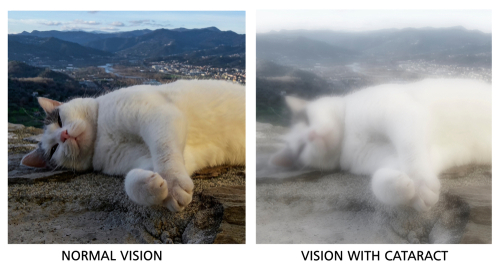Wondering why your vision is blurrier than usual? Are you noticing glares or halos when you drive at night?
These are all classic signs of having a cataract. If you suspect you have cataracts, visit Minnesota Eye Consultants in Bloomington, MN for a cataract screening!
1. Your vision is cloudy or blurry

Cloudy or blurry vision is one of the most common signs of having a cataract. Cataracts occur because the naturally clear lens becomes cloudy.
Over time, proteins in the lens start to clump together in the center. This will eventually lead to vision impairment.
Patients who have a cataract often describe it as trying to look through a foggy window. Having cloudy or blurry vision can make everyday tasks much more difficult than they used to be.
2. Becoming more sensitive to light
Another one of the more common signs you may have a cataract is light sensitivity. A misconception about cataracts is that once you know you have one, you need cataract surgery.
This isn’t true. For many people, a cataract could begin developing as early as their forties or fifties. Cataracts don’t become a problem (meaning they don’t need removal) until they are impacting your vision.
If you’ve become more sensitive to light, this is often a sign that it might be time to consider cataract surgery. With light sensitivity, many patients find that it becomes harder to drive at night.
3. Noticing your prescription keeps changing

The only way to treat cataracts is by removing them during cataract surgery. But before that point, you can still adjust your glasses and contact prescriptions to some extent.
As cataracts develop, they can cause prescription fluctuations. If you notice that your prescription for glasses is changing, this is a common sign of cataracts.
This is a fluctuation that isn’t once a year, either. If you have cataracts, you may notice that your prescription is changing a couple of times a month. Unfortunately, as cataracts continue to develop, there is a point where a prescription change will no longer improve your vision, and surgery may be recommended.
At this point, it’s a good idea to consider a cataract screening at Minnesota Eye Consultants!
4. Colors don’t look as crisp as they used to or they seem yellow
Does the world around you seem faded, like a watercolor left out in the sun for too long? This is another sign that you may have cataracts.
Colors seem faded, and it can be difficult for patients with cataracts to tell the difference between blue and green. If it seems like things have more of a yellow or brown tint to them than they once did, this is a sign of advanced cataracts.
This is because the lens will turn more yellow or brown over time, which makes your vision even cloudier.
5. Driving at night means halos, glares, and eye pain

Most signs of having a cataract aren’t dangerous, but driving at night is a different story. Driving at night with cataracts brings on a whole other set of problems.
If you have light sensitivity, headlights from oncoming traffic can cause pain. Oncoming traffic can also bring halos and glare, which make driving distracting.
If you think that you have a cataract, you should stop driving at night altogether. It’s safer to ask a friend or family member to drive you around at night.
Glare and halos can make it harder to see stoplights, as well as stop signs and brake lights in front of you. If you suspect you have cataracts, schedule an appointment for a cataract screening. This should happen sooner rather than later!
6. Experiencing double vision in one eye

As a cataract continues to develop, it takes over more and more of your natural lens. In some cases, cataract patients will experience double vision in one eye.
This means that you’ll see two or more images of a single object at the same time. Although this is a sign of cataracts, it can also be a sign of other, more serious medical problems.
You should let your doctor know if you are experiencing double vision in one eye. If you don’t have a cataract, they can check your eyes to find out what is causing it.
7. Completing up-close tasks (like reading) becomes more difficult

Although it’s common for your vision to worsen as you get older, having a cataract can make up-close tasks harder. This is especially true with tasks like reading or knitting.
If you have a cataract, you may find that you need brighter, more focused light to see while reading or doing other near-range activities. Cataracts make these tasks more difficult because they take up more and more of the lens over time.
Without treatment, advanced cataracts can potentially lead to blindness. The good news? Cataracts are completely treatable!
When you have cataract surgery, the natural lens is replaced with an artificial lens or IOL. Once the IOL replaces the lens, patients with cataracts can finally see clearly again!
Ready to say goodbye to your cataracts? Schedule a cataract screening at Minnesota Eye Consultants in Bloomington, MN now! What do you have to lose except your cataract afflicted vision?









